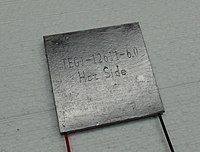
Photo from wikipedia
Thermoelectric materials convert heat energy into electricity, hold promising capabilities for energy waste harvesting, and may be the future of sustainable energy utilization. In this work, we successfully synthesized core-shell… Click to show full abstract
Thermoelectric materials convert heat energy into electricity, hold promising capabilities for energy waste harvesting, and may be the future of sustainable energy utilization. In this work, we successfully synthesized core-shell Bi2Te3/Sb2Te3 (BTST) nanostructured heterojunctions via a two-step solution route. Samples with different Bi2Te3 core to Sb2Te3 shell ratios could be synthesized by controlling the reaction precursors. Scanning electron microscopy images show well-defined hexagonal nanoplates and the distinct interfaces between Bi2Te3 and Sb2Te3. The similarity of the area ratios with the precursor ratios indicates that the growth of the Sb2Te3 shell mostly took place on the lateral direction rather than the vertical. Transmission electron microscopy revealed the crystalline nature of the as-synthesized Bi2Te3 core and Sb2Te3 shell. Energy-dispersive X-ray spectroscopy verified the lateral growth of a Sb2Te3 shell on the Bi2Te3 core. Thermoelectric properties were measured on pellets obtained from powders via spark plasma sintering with two different directions, in-plane and out-of-plane, showing anisotropic properties due to the nanostructure alignment in the pellets. All samples showed a degenerate semiconducting character with the electrical resistivity increasing with the temperature. Starting from Sb2Te3, the electrical resistivity increases with the increase in amounts of Bi2Te3. Thermal conductivity is lowered due to the increase in interfaces and additional phonon scattering. We show that the out-of-plane direction of the BTST 1-3 sample (where 1-3 indicates the ratio of BT to ST) demonstrates a high Seebeck value of 145 μV/K at 500 K which may be attributed to an energy filtering effect across the heterojunction interfaces. The highest overall zT is observed for the BTST 1-3 sample in the out-of-plane direction at 500 K. The zT values increase continuously over the measured temperature range, indicating a probable higher value at increased temperatures.
Journal Title: ACS applied materials & interfaces
Year Published: 2022
Link to full text (if available)
Share on Social Media: Sign Up to like & get
recommendations!